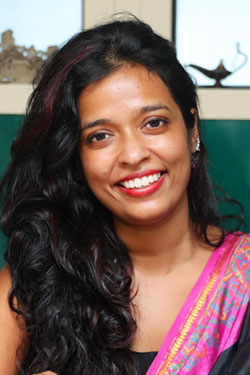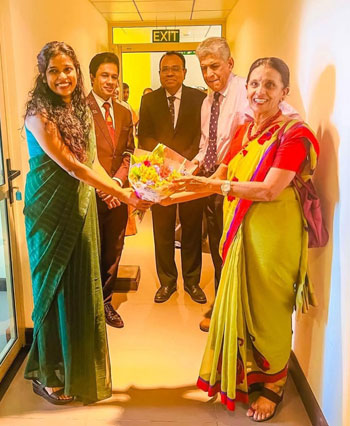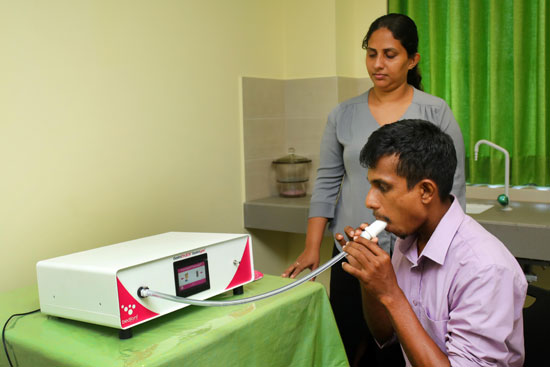A first for Sri Lanka: A device to detect GI disorders
Clad in her best sarees, she walked the corporate corridors, begging for a simple piece of equipment.
Her yearning to “improve the quality of life” of thousands of people affected by gastrointestinal (GI) disorders was fulfilled on June 18, when the equipment worth over Rs. 8 million was donated not by a corporate but by veteran doctor-couple, Physician Dr. Anula Wijesundere and Obstetrician & Gynaecologist Dr. Ajita Wijesundere and their daughter Dr. Dishni Wijesundere, all three of whom are alumni of the University of Colombo, Faculty of Medicine (UCFM).

Dr. Nilanka Wickramasinghe
It is a first for Sri Lanka – this simple box-like ‘hydrogen and methane device’, now in a bright room with calming green curtains, part of the Gastrointestinal (GI) Physiology Research Laboratory, on the 6th Floor of the UCFM tower off Maradana Road, Colombo 7.
“The donation was a simple ceremony,” says Dr. Nilanka Anjalee Wickramasinghe, Senior Lecturer at the Department of Physiology, Faculty of Medicine, as she shows the device with its tube into which patients have to blow, to the Sunday Times on Tuesday.
The immense discomfort and difficult times faced by those with GI disorders, even though not a life and death issue, have been troubling Dr. Wickramasinghe as her special interest is nutrition.
Having qualified as a doctor and now armed with a Master’s Degree in Human Nutrition along with a massive tome-like doctoral (PhD) thesis in gastrointestinal physiology, she says that research on some common GI issues such as lactose intolerance in Sri Lanka is sparse.
All to do with the very essence of life which is eating and drinking for survival, before we move onto the functions of the device, Dr. Wickramasinghe looks at digestion – how food is converted into their simplest forms or broken down for easy absorption into the bloodstream. This process starts with the mouth, pharynx (throat), oesophagus (gullet), stomach, small intestine, large intestine (large bowel or colon) and ends with the anus.
Zeroing in on the gut, she explains that ‘lactase’, an enzyme produced in the small intestine, usually helps breakdown lactose, the sugar found in milk and dairy products, to simpler sugars (glucose and galactose). However, some people do not produce enough of this enzyme, which leads to undigested lactose moving down to the large intestine. The normal bacteria present here interact with the undigested lactose, causing the symptoms of lactose intolerance or malabsorption.

Dr. Nilanka Wickramasinghe (left) presents a bouquet to Dr. Anula Wijesundere. Looking on (from right) are Dr. Ajita Wijesundere; the Dean of the Colombo Medical Faculty, Prof. Vajira H.W. Dissanayake; and the Vice Chancellor of the Colombo University, Prof. Indika Karunathilake
Such people suffer from symptoms such as diarrhoea, flatulence (gas) and bloating, after they eat or drink dairy products, making life miserable for them. The blanket answer by doctors has been – avoid dairy products to reduce symptoms; take enzyme supplements to fix the digestive problems; and consume probiotics and prebiotics to improve gut health.
While lactose intolerance is quite common, other GI issues include fructose intolerance (inability to absorb the natural sugar fructose found in fruit, some vegetables and honey); sorbitol intolerance (difficulty in digesting sorbitol, a sugar alcohol found in many foods and also used as a sweetener); Small Intestine Bacterial Overgrowth (SIBO); Irritable Bowel Syndrome (IBS); Exocrine Pancreatic Deficiency; and Oro Cecal Transit Time (OCTT).
“This is where the non-invasive hydrogen and methane device comes in handy,” says Dr. Wickramasinghe, explaining that it has laser sensor technology; two sample modes for remote breath testing via a breath bag and direct testing via a mouthpiece and full-colour touch screen.
The test involves blowing into the small tube attached to the device. This is the first sample, after which the person is told to drink a sugary solution for more breath samples. The testing period lasts around three hours.
This breath test evaluates the digestion of specific sugars by measuring the gas, usually hydrogen and methane, exhaled by a person after eating foods containing sugars and carbohydrates (starch). Usually, these foods should be pre-digested before reaching the colon but in those who have GI issues, they do reach the colon.
Once such undigested food reaches the colon, the bacteria present there ferment this food, converting it to gas. This gas is absorbed into the bloodstream, carried into the lungs and exhaled (sent out) when breathing. The hydrogen breath test measures hydrogen levels in a person’s breath after eating a particular food. As different people have varying ‘assortments’ of gut bacteria, some would have more methane in their breath than hydrogen and this too would be detected by the device.
“This is how a person’s breath can show what is going on in the gut,” adds Dr. Wickramasinghe.

Hydrogen and methane device with its tube into which patients have to blow. Pix by Eshan Fernando
| How to contact the lab | |
| While the GI Physiology Research Laboratory awaits referrals from any doctor or hospital across the country, the public may call on Mobile: 0715959836 or Email: nilanka@physiol.cmb.ac.lk for more information between 8 a.m.-4 p.m. on weekdays. |
Searching for an ideal partner? Find your soul mate on Hitad.lk, Sri Lanka's favourite marriage proposals page. With Hitad.lk matrimonial advertisements you have access to thousands of ads from potential suitors who are looking for someone just like you.


